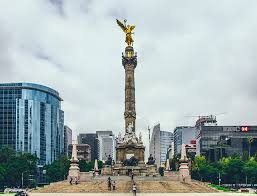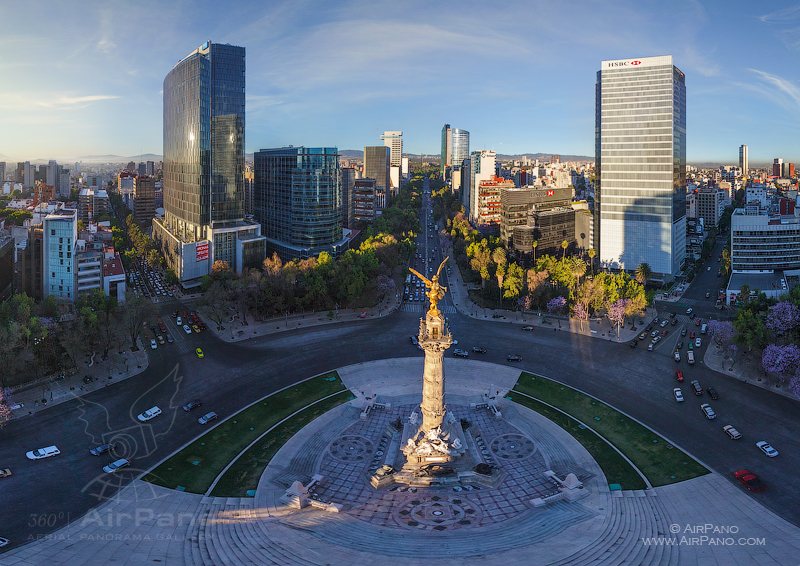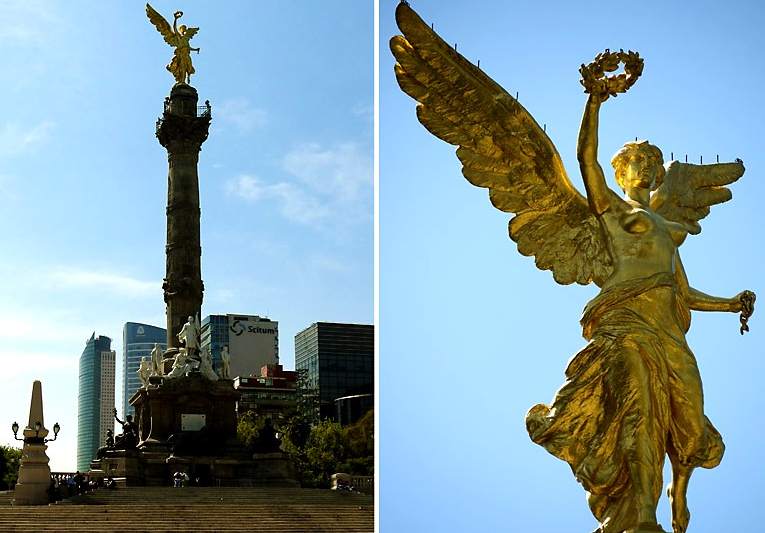The Angel of Independence, most commonly known by the shortened name El Ángel and officially known as Monumento a la Independencia ("Monument to Independence"), is a victory column on a roundabout on the major thoroughfare of Paseo de la Reforma in downtown Mexico City.
El Ángel was built in 1910 during the presidency of Porfirio Díaz to commemorate the centennial of the beginning of Mexico's War of Independence. In later years it was made into a mausoleum for the most important heroes of that war. It is one of the most recognizable landmarks in Mexico City, and it has become a focal point for both celebration or protest. It resembles the July Column in Paris and the Berlin Victory Column in Berlin.
The base of the column is quadrangular with each vertex featuring a bronze sculpture symbolizing law, war, justice and peace. Originally there were nine steps leading to the base, but due to the sinking of the ground, an ongoing problem in Mexico City, fourteen more steps were added.
On the main face of the base facing downtown Mexico City, there is an inscription reading La Nación a los Héroes de la Independencia ("The Nation to the Heroes of Independence"). In front of this inscription is a bronze statue of a giant lion led by a child, representing strength and the innocence of youth during War but docility during Peace.
Next to the column there is a group of marble statues of some of the heroes of the War of Independence. The column itself is 36 metres (118 ft) high. The structure is made of steel covered with quarried stone decorated with garlands, palms and rings with the names of Independence figures. Inside the column is a two-hundred step staircase which leads to a viewpoint above the capital. The Corinthian-style capital is adorned by four eagles with extended wings from the Mexican coat of arms used at the time.
Crowning the column there is a 6.7 metres (22 ft) statue by Enrique Alciati of Nike, the Greek goddess of Victory, like other similar victory columns around the world. It is made of bronze, covered with 24k gold (restored in 2006) and weighs 7 tons. In her right hand the Angel, as it is commonly known, holds a laurel crown above Miguel Hidalgo's head, symbolizing Victory, while in her left she holds a broken chain, symbolizing Freedom.
Construction of El Ángel was ordered in 1900 by President Porfirio Díaz. Gen. Porfirio Díaz began the foundation work immediately and laid the foundation stone on January 2, 1902 and placed in it a gold chest with a record of independence and a series of coins minted in that epoch. But in May 1906, when the foundations were built and 2,400 stones placed to a height of 25 m, the sides of the monument collapsed, so Díaz created a study commission composed of engineers Guillermo Beltran y Puga, Manuel Marroquín y Rivera and Gonzalo Garita. The commission determined that the foundations of the monument were poorly planned, so it was decided to demolish the structure. The work was restarted under the supervision of a steering committee composed of engineers Guillermo Beltran y Puga, Manuel Marroquin y Rivera and the architect Manuel Gorozpe, leaving the artwork in the care of architect Antonio Rivas Mercado. All the sculptures were made by Italian artist Enrique Alciati. The monument was completed in time for the festivities to commemorate the first hundred years of Mexican Independence in 1910. The opening ceremony was attended by President Díaz and several foreign dignitaries. The main speaker at the event was Mexican poet Salvador Díaz Mirón.
An eternal flame (Lámpara Votiva) honoring these heroes was installed in the base of the column at the order of President Emilio Portes Gil in 1929.
The monument suffered some damage during an earthquake on July 28, 1957 when the sculpture of the Winged Victory fell to the ground and broke into several pieces. Sculptor José Fernández Urbina was in charge of the restoration, which lasted more than a year. The monument was reopened on September 16, 1958. It survived the devastating earthquake of September 19, 1985 with some damage to the staircases and the reliefs, but none to the Angel.












